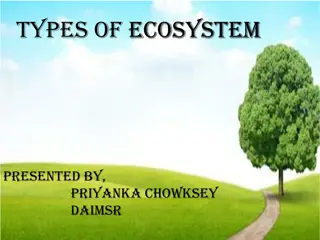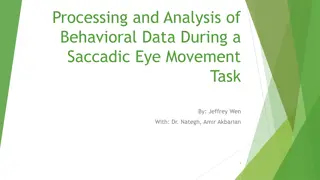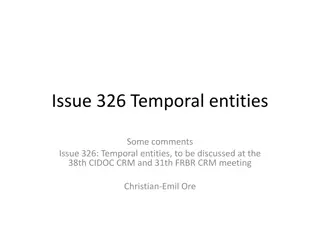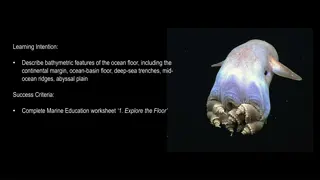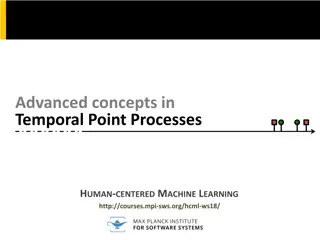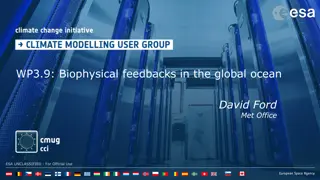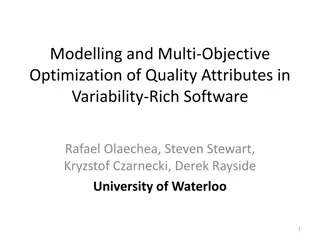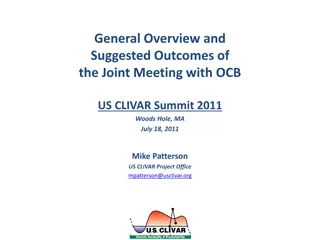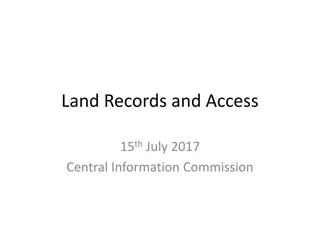Understanding Temporal Variability of Ecosystem Processes across Land and Ocean
This content delves into the broad-scale and cross-scale ecosystem processes on land and in the ocean, exploring their temporal variations influenced by underlying structures, biodiversity, and climate. It emphasizes the importance of considering structure, function, and climate response simultaneously to build predictive capacity. Additionally, it discusses the interactions between human and natural systems, the impact of activity patterns on Earth systems, and the vulnerabilities in transition zones. The content also raises questions about biodiversity attributes, temperature sensitivities of global ecosystems, and energy exchanges in vulnerable regions.
- Ecosystem Processes
- Temporal Variability
- Biodiversity
- Human-Natural System Interaction
- Climate Change
Download Presentation

Please find below an Image/Link to download the presentation.
The content on the website is provided AS IS for your information and personal use only. It may not be sold, licensed, or shared on other websites without obtaining consent from the author. Download presentation by click this link. If you encounter any issues during the download, it is possible that the publisher has removed the file from their server.
E N D
Presentation Transcript
Breakout group #3 32 attendees Key crosscutting themes/ assumptions Measurement continuity Feedbacks Limitations of models (e.g. biotic stationarity) Error and uncertainty Human-natural system interaction Physical drivers Process-level understanding and predictive capacity
How do (broad-scale / cross-scale) ecosystem processes (land, ocean) vary temporally as a function of underlying structure & biodiversity [and climate]? i.e. Simultaneous consideration of structure, function, climate response. Build process-level predictions of how they vary Consider impact on livelihoods of human populations Characterize the relations between fast and slow processes (e.g. immediate photosynthesis versus long-term C sequestration, ocean NPP versus sedimentation) What biotic traits (wrt various dimensions of biodiversity) can best capture interactions w/in coupled surface (land, ocean) atmosphere models? Can we capture the extent of, and changes in, biodiversity attributes Genetic, traits, functional traits How do activity patterns between human and natural systems drive change in the Earth system? Land use change (Land transformation, competition for land) ->> climate change feedbacks e.g. need to know about human activity along a road, not just that the road exists What are material and energy exchanges in potentially vulnerable natural (and probably changing) transition zones, and their effects on human systems (or life including humans )? Under-sampled / understudied areas in particular Transition zones particularly vulnerable / fragile? e.g. land-ocean interface, coastal wetlands, treeline, ecotones What are the temperature and CO2 sensitivities of global ecosystems, and their climate feedbacks? Slow progress in resolving missing sink, ecosystem response, global climate sensitivity
Breakout Group 3 32 attendees Little difference between core ?s for land and ocean? How different are communities? Land-sea interface tends to get lost; continuum Emphasis on C can be misleading (though NB has direct climate effects); can we fine-tune? Some political traps here, too What will we still want to know 10 years from now? Co-evolution of human and natural systems, watershed/coastal, integrated assessment, nonlinear responses? Water, freshwater resources, food security Capacity of earth to sustain life (mechanisms, capacity, changes) Energy use How much are we willing, as a community, to ask/pursue socially- charged/uncomfortable questions? I.e. putting research in human-natural systems context? Let agencies handle political spinning ? But there s a lot of pressure pushing the opposite direction, too: broader impacts, communication and engagement, etc. Engagement also helps multidisciplinary research (e.g. recent ABoVE call w.r.t. human context) Or should this community focus on historic strengths w/ measurements and instruments?
Opportunity: undersampled parts of world Matt Hansen and Landsat limitations over Africa GDP paradox how do we get good measurements in underdeveloped/remote places without good science? Might help: move towards integrated data products, not sensor-specific as much Change and continuity note ocean community lost 11 years! KD: tired of PFT-based models; our observations now can pick up individual trees, why can t models take advantage of this fully? Gaps between measurements and understanding this happens in a number of areas. Ties well to themes of scaling and process PFTs -> traits -> species We re in a golden age of airborne, not just space-based, msmts
Overarching, interdisciplinary, compelling science questions! Need to understand the players functional emphasis. What is the impact in models of understanding structure on process? Detailed structure can actually make existing models worse What gets lost as our inferences cross scales? What can we lose, and what can we not? Temporal scale: process scale (e.g. in atmosphere) matters a lot, esp. when reconciling process understanding with observations. Matters a lot for models too. Keep flexible time scales very important for certain systems What are spatial scales that drive variability? Then, what processes happen at those scales, and how do we parameterize them? What is biodiversity of world, how is it changing? Future of biosphere depends on adaptation, evolution, and sustainability: requires us to understand change and continuity. Biodiversity affects processes Similar questions could be asked about water resources, food resources, climate, energy availability Big questions often link pattern and process What is the fate of NPP, e.g.?
How do ecosystem processes vary diurnally and seasonally, as a function of underlying structure, biodiversity, and climate? (Simultaneous consideration of structure, function, climate response.) predictive capabilities can we predict how they vary? What is impact on livelihoods of human populations? Habitat fragmentation this applies to ocean and terrestrial how does fragmentation and subsequent ecological simplification feed back to C fluxes, etc.? Can we capture the full range of biodiversity what it really is? Genetic, traits, functional traits? Are there emergent traits (w.r.t. various dimensions of biodiversity) that can better capture interactions w/in coupled surface atmosphere models? In ocean, we don t have a good idea about respiratory processes and rates. This is true for land as well What processes are not well captured and so need our attention (ultimately wrt measurements) For both process understanding and prediction Biodiversity, wrt trait functional diversity rather than species Species can have highly variable structure in different environments Composition is important wrt capturing process in models
How do (broad-scale / cross-scale) ecosystem processes vary temporally as a function of underlying structure, biodiversity and climate? i.e. Simultaneous consideration of structure, function, climate response. predictive capabilities can we predict how they vary? What is impact on livelihoods of human populations? Characterization of the relations between fast and slow processes (e.g. immediate photosynthesis versus long-term C sequestration, ocean NPP versus sedimentation) What biotic traits (wrt various dimensions of biodiversity) can best capture interactions w/in coupled surface-atmosphere models? Can we capture the extent of, and changes in, biodiversity what it really is? Genetic, traits, functional traits? How do activity patterns between human and natural systems drive change in the Earth system? May want to call out land use change, climate change! Feedbacks? E.g.: we want to know about activity on a road, not just that the road exists What are material and energy exchanges in (potentially vulnerable natural and and probably changing) transition zones, and their effects on human systems (or life including humans )? maybe transition zones (treeline, biomes) in general understudied? Transition zones as particularly vulnerable/fragile? E.g. land-ocean, coastal wetlands What are the temperature and CO2 sensitivities of global ecosystems, and their climate feedbacks? The Friedlingstein figure question NB slow progress in resolving missing sink, ecosystem response, global climate sensitivity
Discipline-specific Coastal zones as underrepresented areas of study Ocean acidification



